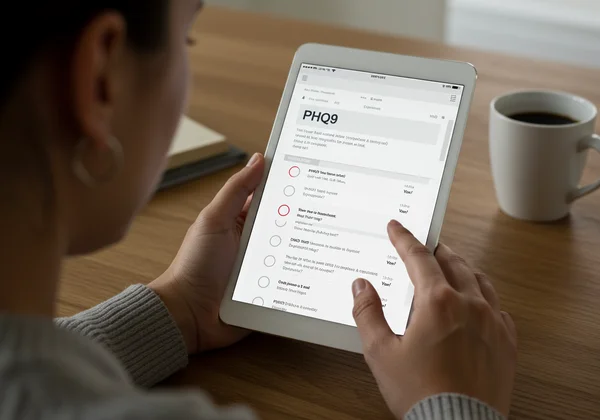PHQ9 Questions Explained: Meaning & Interpretation Guide
Feeling overwhelmed or disconnected from your emotions can be an isolating experience. You might sense that something is off but struggle to put it into words. The Patient Health Questionnaire-9, or PHQ9, is a respected and valuable first step toward clarity. But to truly unlock its power, you need to understand what each question is really asking. What does the PHQ9 score mean if the answers aren't a true reflection of your feelings?
This guide will walk you through every one of the questionnaire's questions, helping you translate your recent experiences into accurate answers. By understanding the meaning behind the assessment, you can gain deeper, more reliable insights into your emotional well-being. When you're ready, you can start your emotional checkup with confidence.

Decoding PHQ9 Questions 1-8: Common Depression Symptoms
The first eight questions of this screening instrument are designed to screen for the core symptoms of depression as defined in clinical settings. They explore shifts in your mood, body, and thoughts. Answering them honestly is key to getting a meaningful result from the assessment.

Loss of Interest & Low Mood: Questions 1 & 2 Explained
These first two questions are the cornerstones of the questionnaire. They address the two most significant indicators of depression: anhedonia and a persistently low mood.
-
Question 1: "Little interest or pleasure in doing things" This item explores anhedonia, a term for the reduced ability to experience pleasure. Think about the activities you usually enjoy—hobbies, spending time with friends, watching your favorite show. Have these activities felt less appealing or even like a chore over the last two weeks?
-
Question 2: "Feeling down, depressed, or hopeless" This question directly assesses your depressed mood. It’s about more than just having a bad day. It looks for a persistent feeling of sadness, emptiness, or a sense that things will never get better. Reflect on whether a cloud of negativity has been following you around recently.
Sleep, Energy, and Appetite Shifts: Questions 3, 4 & 5
Mental health is deeply connected to physical health. These questions examine the physiological symptoms that often accompany emotional distress, making them a key part of the assessment tool.
-
Question 3: "Trouble falling or staying asleep, or sleeping too much" Your sleep changes are a strong indicator of your mental state. This includes both insomnia (difficulty sleeping) and hypersomnia (sleeping much more than usual). Consider if your sleep patterns have been disrupted without a clear external reason.
-
Question 4: "Feeling tired or having little energy" This probes into fatigue that goes beyond normal tiredness. It’s a deep sense of weariness that isn't relieved by rest. Have your energy levels been so low that even simple tasks feel exhausting?
-
Question 5: "Poor appetite or overeating" Significant appetite shifts are common. Some people lose their appetite entirely, while others turn to food for comfort and overeat. Think about whether your relationship with food and your eating habits have noticeably changed.
Self-Worth, Focus, & Movement: Questions 6, 7 & 8 Insights
The final questions in this section explore cognitive and self-perception symptoms. These internal experiences are just as important as the more visible behavioral ones.
-
Question 6: "Feeling bad about yourself—or that you are a failure or have let yourself or your family down" This item targets feelings of low self-worth or excessive guilt. It’s about an internal critic that has become overly harsh. Have you been plagued by thoughts of inadequacy or that you are a burden to others?
-
Question 7: "Trouble concentrating on things, such as reading the newspaper or watching television" Difficulty with concentration is a classic sign of mental strain. If you've found your mind wandering constantly or struggled to follow a plot or conversation, it points to focus issues that this tool helps identify.
-
Question 8: "Moving or speaking so slowly that other people could have noticed? Or the opposite—being so fidgety or restless that you have been moving around a lot more than usual" This addresses psychomotor changes. It can manifest as a noticeable slowing down of your movements and speech or, conversely, as a restless agitation. These physical changes are often more apparent to others before you notice them yourself.
The Critical 9th PHQ9 Question: Suicidal Thoughts Explained
This final question is the most sensitive and arguably the most important part of the assessment. It is handled with special care because it directly addresses safety. Understanding suicide ideation as addressed by the PHQ9 is crucial for both the person taking the test and any caregiver or professional reviewing the results.

Understanding the Significance of Question 9 in PHQ9 Assessment
- Question 9: "Thoughts that you would be better off dead, or of hurting yourself in some way"
This question is a direct inquiry about thoughts of self-harm or suicide. Any answer other than "Not at all" is a significant finding, regardless of the total score. It serves as a critical flag that immediate attention and support are needed. It is not a sign of weakness to have these thoughts, but it is a clear signal to seek help.
What to Do If You're Experiencing Suicidal Thoughts
If you answer "Several days," "More than half the days," or "Nearly every day" to this question, it is essential to take immediate action. Your safety is the top priority.
- Talk to Someone Now: Do not keep these thoughts to yourself. Reach out to a mental health professional, a doctor, a trusted friend, or a family member.
- Contact a Crisis Line: These services are free, confidential, and available 24/7.
- National Suicide Prevention Lifeline: Call or text 988 in the US and Canada.
- Crisis Text Line: Text HOME to 741741.
- The Trevor Project: 1-866-488-7386 (for LGBTQ youth).
- Seek Professional Help: Your results can be a powerful tool to start a conversation with a healthcare provider who can help you create a safety plan and find the right support.
Maximizing Your PHQ9 Understanding Beyond Individual Items
Answering the questions is the first step; understanding how they work together is the next. A solid PHQ9 item interpretation involves seeing how each answer contributes to the bigger picture of your emotional health.
How Your Answers Contribute to the Overall PHQ9 Score Meaning
For each of the nine questions, you select a response corresponding to a point value: "Not at all" (0 points), "Several days" (1 point), "More than half the days" (2 points), or "Nearly every day" (3 points). Your total score is the sum of these points, ranging from 0 to 27. This score provides a snapshot of the severity of depressive symptoms.
This scoring system helps you and your provider track your symptoms over time. By taking the questionnaire periodically, you can see if your symptoms are improving, staying the same, or worsening. It provides a concrete way to measure progress on your mental health journey. After you understand your score, you can make more informed decisions.
When Self-Assessment Leads to Professional Insight
Remember, this screening tool is a highly effective screening tool, but it is not a diagnosis. It identifies the presence and severity of symptoms. Only a qualified healthcare professional can provide a full evaluation and diagnosis.
Use your results as a conversation starter. Bringing your score to a doctor or therapist gives them valuable, standardized information about your experience. Additionally, you can opt for an AI-powered personalized analysis, which can provide deeper professional insight into your unique strengths and challenges, further empowering your conversation with a provider.

Empowering Your Emotional Health Journey with PHQ9 Understanding
Understanding the meaning behind each question transforms it from a simple quiz into a powerful tool for self-reflection. It allows for a more accurate and nuanced check-in with your emotional state. This knowledge empowers you to take control of your mental health journey, starting with a clear, honest assessment.
You now have the guide to do just that. Take the next step toward clarity and well-being. Take the free assessment today, confident in your ability to answer thoughtfully and interpret your results meaningfully.
Frequently Asked Questions About PHQ9 Questions and Meaning
What is the PHQ-9 test used for?
The PHQ-9 is a multipurpose tool used for screening, monitoring, and measuring the severity of depression. It is one of the most common screening instruments used in primary care and mental health settings to quickly identify potential depressive symptoms that may require further evaluation.
How does each question contribute to my total score?
Each of the nine questions corresponds to a criterion for major depressive disorder. Your answer for each—"Not at all," "Several days," "More than half the days," or "Nearly every day"—is assigned 0, 1, 2, or 3 points, respectively. Your total score is the sum of these points, giving a quantitative measure of your symptom severity over the past two weeks.
Can this questionnaire accurately diagnose depression?
No. This is a critical point. The questionnaire is a screening tool, not a diagnostic one. While it can accurately identify the presence and severity of depressive symptoms, a formal diagnosis of depression can only be made by a qualified healthcare professional after a comprehensive evaluation. Think of the assessment as a thermometer: it tells you if you have a fever, but a doctor is needed to diagnose the illness causing it.
Is this questionnaire a reliable assessment tool for depression symptoms?
Yes, the PHQ-9 is a highly reliable and clinically validated tool. It has been extensively researched and is widely used by clinicians and researchers around the world. Its consistency and accuracy in measuring depressive symptoms make it a trusted first step in mental health assessment.
Who should take this screening questionnaire?
Anyone can benefit from taking this questionnaire. This includes individuals who are simply curious about their emotional health, those feeling persistently down or anxious, caregivers concerned about a loved one, or patients with chronic illnesses monitoring for co-occurring depression. The broad PHQ 9 age range and its availability in multiple languages make it accessible to a wide audience. Ready to see where you stand? You can begin your assessment here.